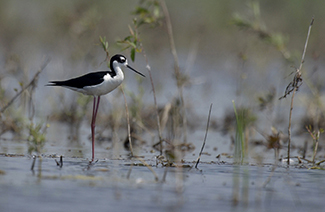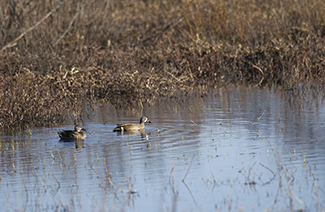Improving habitat at Pointe Mouillee State Game Area
By HOLLY VAUGHN
Michigan Department of Natural Resources

Those who live in or visit “downriver” Michigan – in the southeastern corner of the state – know the place to go for great waterfowl hunting, fishing and wildlife viewing opportunities is Pointe Mouillee State Game Area.
Located in Rockwood, on the western shore of Lake Erie in Wayne County, Pointe Mouillee is one of the largest freshwater marsh restoration projects in North America. The area is composed of 4,040 acres of cattail marsh, field, coastal wetland and forest.
With a wide variety of habitat types, Pointe Mouillee boasts an excellent diversity of wildlife, especially bird species. As a migrant trap (a site where migrating birds stop to rest and feed) in Lake Erie, the area hosts many migrating ducks and geese in the fall, in addition to some rare avian visitors.
“In recent years, glossy and white-faced ibises, black-necked stilts, a white wagtail, king rails and a black-headed gull have made appearances in the marsh – birds that are generally found in Florida or Alaska,” said Zach Cooley, a Michigan Department of Natural Resources wildlife biologist at Point Mouillee.
To boost its benefits to wildlife, Pointe Mouillee recently underwent massive habitat improvements to Stony Island, a 52-acre island in the Detroit River that is part of the game area. The island is located just east of Grosse Isle.
The Friends of the Detroit River were awarded a $7 million grant to improve wildlife habitat on and around Stony Island. The grant is funded by the National Oceanic and Atmospheric Administration as part of the Great Lakes Restoration Initiative.
|

Partners in the restoration project include the Friends of the Detroit River, the DNR, E.C. Korneffel Company, and Environmental Consulting & Technology, Inc.
“Over the years, high water, waves and ice scouring have destroyed the protective shoals around the island,” Cooley said. “The habitat work on Stony Island has restored 3,487 linear feet of habitat shoals and 550 linear feet of shoal island, which will help to protect 50 acres of backwater habitat behind the shoals.”
The shoals also provide extensive nesting habitat for birds, including common terns, which have been a state threatened species in Michigan since 1978.
More than 100 additional habitat structures were built for other birds and for nesting turtles, hibernating snakes, mudpuppies and mussels.
The project has increased tern, reptile and fish abundance and wildlife diversity.
Similar habitat work is being conducted on neighboring Celeron Island off the south end of Grosse Isle, which is also part of Pointe Mouillee State Game Area.
The Stony Island habitat restoration project has been awarded the National American Public Works Association Project of the Year (in the $5 million - $25 million category). The national award will be presented Sept. 9 in Seattle.
The project also won the State American Public Works Association project of the year award, which was awarded in May. The annual award is granted for infrastructure projects publicly developed, owned and maintained, that promote excellence in construction management and administration.
“We are proud to be part of this project and look forward to seeing how these habitat improvements benefit wildlife at Pointe Mouillee,” Cooley said.
These awards recognize the alliance between the managing agency, contractor and consultant and their cooperative achievements.
|

The Pointe Mouillee State Game Area is one of Michigan’s Wetland Wonders.
Additional Wetland Wonders include premier managed waterfowl hunt areas in the state: Fennville Farm Unit at the Allegan State Game Area (Allegan County), Fish Point State Wildlife Area (Tuscola County), Harsens Island at the St. Clair Flats State Wildlife Area (St. Clair County), Muskegon County Wastewater Facility (Muskegon County), Nayanquing Point State Wildlife Area (Bay County) and Shiawassee River State Game Area (Saginaw County).
Check out a sidebar story on hunting Michigan’s Wetland Wonders.
These areas, scattered across the southern Lower Peninsula, were created in the 1950s and 1960s to provide exceptional waterfowl hunting and wildlife viewing opportunities, and are still managed today to provide waterfowl habitat for nesting and migrating birds, as well as benefit other types of wetlands wildlife.
Since their creation, Michigan’s Wetland Wonders have been funded by hunting license fees, but they are open for anyone to visit, use and enjoy most of the year.
“Our managed waterfowl hunt areas offer access to some of the best waterfowl hunting and wildlife viewing in the state,” said Barb Avers, DNR waterfowl and wetlands specialist. “It’s no surprise that several of our Wetland Wonders are among the top waterfowl hunting and birdwatching destinations in Michigan.”
For more information about how the DNR manages wildlife habitat, visit Michigan.gov/Wildlife.
|
Check out previous Showcasing the DNR stories in our archive at Michigan.gov/DNRStories. To subscribe to upcoming Showcasing articles, sign up for free email delivery at Michigan.gov/DNR.
/Note to editors: Contact: John Pepin, Showcasing the DNR series editor, at 906-226-1352. Accompanying photos and a text-only version of this story are available below for download and media use. Suggested captions follow. Credit: Michigan Department of Natural Resources, unless otherwise noted.
Text-only version of this story.
Ducks and Geese: Pointe Mouillee and the other managed waterfowl hunt areas scattered across the southern Lower Peninsula provide habitat for nesting and migrating birds, including ducks and geese, and other types of wetland wildlife. The ducks pictured are blue-winged teal.
Hunter: Michigan’s Wetland Wonders – the seven premier managed waterfowl hunt areas around the state, including Fish Point State Wildlife Area in Tuscola County, pictured here – offer exceptional waterfowl hunting opportunities.
Stilt: As a stopping point for migrating birds, Pointe Mouillee State Game Area hosts some rare avian visitors like the black-necked stilt in addition to many ducks and geese in the fall.
Stony Island aerial: Aerial shot of the island and the protective shoals.
Terns: Common terns, a state-designated threatened species in Michigan, are found on Stony Island.
Wetland: The shoals protect the backwater wetlands on Stony Island./
|